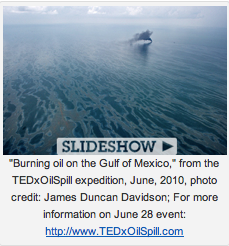The power of new sun that is, not the fossil kind captured by plants millions of years ago and transformed into oil, coal and gas. Old sun is best left underground, underwater, under salt seals, in mountains and far, far away from tail pipes and smokestacks. Old sun warms the Earth in all the wrong ways. New sun offers a way out of Dodge.
We have loads of clean / cleaner energy options beyond solar (photovoltaic, water heating):
- wind power (macro and micro)
- fuel cells (e.g., the Bloom box)
- biofuels (check out Willie Smits’ on tapping sugar palms sap for ethanol - no tree-cutting required)
- distribution (distributed power generation and smarter grids)
| |
DEMAND: THE OTHER PART OF THE EQUATION
As Nocera points out, unless we get a hold of demand, energy supply is always going to be a game of catch-up – as it is for resources of every kind. Casting the issue in terms of per capita usage actually provides a perverse incentive for over-population.
Rather, the question isn’t how to most equitably divvy up a finite fossil fuel pie, but how much energy is needed for people to live happy, healthy, productive, environmentally-compatible lives.
The education of women in developing countries, which has been shown to correlate to family-planning, along with easier access to contraceptives, are key for a successful global energy strategy.
Business-as-usual means that “every three years, a new Saudi Arabia needs to be discovered and exploited just to maintain the level of output,” according to Antony Froggatt, a senior research fellow at British think tank, Chatham House and co-author on a new report co-produced with insurance giant Lloyd’s of London on business-smart energy strategies: Sustainable Energy Security: Strategic Risks and Opportunities for Business.
| |
So how do we put more “bounce” back in the system? Clearly not by continuing to pour money into vulnerable pipelines, pirate-friendly tanker ships, inefficient central power generation plants, “dumb” grids and top-down one-size-fits-all answers driving an ever-depressing downward spiral, greased by oil spills.
How do we transition to the dazzling variety of better technologies that are either already on the shelf or on the near-term horizon? This is a business and logistics question, not a technical question (which is not to say that substantial and steady R&D funding isn’t required – it most definitely is).
If the Chatham House report is right, things will start to get really dicey by 2013, when China’s domestic oil production is expected to peak and competition for global supplies becomes even more fierce.
REINVENTING FIRE
Few people have been as tenaciously focused on saving the world from its fossil fuel addiction as Amory Lovins, chief scientist and cofounder of the Colorado-based “think and do tank,” Rocky Mountain Institute (RMI). For over 30 years, Lovins, a geek’s geek, has relentlessly and with trademark statistic-laced cheer, shown how saving energy is almost always cheaper than generating it (“negawatts” and “negabarrels”) and how thoughtful design can translate, often immediately, to the bottom line.
When Detroit declared that cars were as efficient as they were ever going to be, Lovins set about reinventing the auto as a “Hypercar,” experimenting with carbon-composite plastics (light-weighting and saves on “paint shop” costs), LED lights, hydrogen fuel cells, better insulation to cut A/C needs and low drag design. While the team was at it, they did away with the steering wheel in favor of joystick, too. Voila! 100 mpg. Many of the technologies (though, so far, not the joystick) have been adopted by major manufacturers (video).
Green building design has always been a central part of the RMI’s work, starting with Lovins’ own home, The Banana Farm, nestled in the Rockies of Snowmass, CO. The most ambitious project so far: a $13.2 million retrofit of the Empire State Building, designed to save just under $4 million in energy costs per year.
As impressive as these projects are, they are the warm up for what may very well be Lovins’ masterwork: Reinventing Fire. RF, a new research initiative just getting underway, builds on work from an earlier project, “Winning the Oil Endgame,” a business-driven road map for weaning the U.S. off oil by 2050. Lovins explains in this TED talk from 2005:
| |
With the clear-headed cunning that comes from decades at the front lines, the RMI team has carefully chosen its battles:
In the web of interconnections spanning how energy is produced, transported, distributed and used, all the points along the way are fair game for intervention. But decades of research into how energy moves from fossil-fuel sources to uses have revealed key leverage points in four sectors: transportation, buildings, industry and electricity.
SMALL PEOPLE POWER
There is no need for the rest of us to wait on the sidelines while Business gets its profit-priorities in gear. Plenty of revolutions – maybe most – start with “the small people,” as English-as-a-second-language-challenged BP Chairman Carl-Henric Svanberg dubbed us.
In addition to seeking out energy-smart products, insulating our homes and lobbying for more and better public transportation options, we can begin to think more about what we eat and where it comes from.
Much of what appears an America’s dinner plates took thousands of miles to get there. Calves born in Florida might be “finished” in a feedlot in Nebraska and shipped as hamburger to a grocery story in Illinois. Fresh fruits and vegetables are no longer about the bounty of season, but flight logistics. The loss of shrimping in the Gulf from the oil spill doesn’t only mean lost jobs, it means more imports from overseas.
From running farm machinery, to inputs for pesticides and herbicides and, of course, shipping, an enormous amount of fossil fuel goes into food. It is time we put a fork in it: “Small people for locally or regionally-produced food!” If we can up the percentage to just 25% of our collective plate, not only would it force a change in production logistics, but we would be healthier for our efforts. A lot of vitamins get lost in transit…
The urban agriculture movement, which puts farms in the middle of cities, shortens the loop about as much as it can be shortened. As pioneered by MacArthur fellow Will Allen at Milwaukee- based Growing Power’s flagship farm, fish can be added to the harvest through a closed loop aquaponics set up where plants filter water while fish fertilize plants (see TrackerBlog post: “The Farm Next Door”).
BP: BEYOND PROPOGANDA
In a recent interview with the New York Times, the wife of a Gulf coast oil worker spoke about her conflicting feelings between the need for jobs right now and the high environmental costs of drilling.
“I mean, eventually we might figure out a way to switch over to something else for us to use for energy,” she said. “But is it going to be affordable for everybody?
There is no time left for “eventually.” You want that better future back? Let’s go get it.?
- TEDxOilSpill: June 28, 2010 – livestreaming from Washington D.C.
- “The Spill, the Scandal and the President” by Tim Dickinson, Rolling Stone
- “Obama’s Sherriff” by Tim Dickinson, Rolling Stone
- “Far From Gulf, a Spill Scourge 5 Decades Old” by Adam Nossiter, New York Times
- “Energy (R)evolution: A Sustainable World Energy Outlook” - Greenpeace website / pdf report











